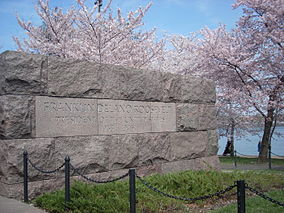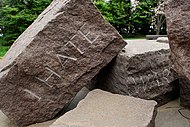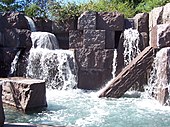Franklin Delano Roosevelt Memorial
| Franklin Delano Roosevelt Memorial | |
|---|---|
IUCN category V (protected landscape/seascape) | |
 | |
| Location | Washington, D.C., United States |
| Coordinates | 38°53′2″N 77°2′40″W / 38.88389°N 77.04444°WCoordinates: 38°53′2″N 77°2′40″W / 38.88389°N 77.04444°W |
| Area | 7.50 acres (3.04 ha) |
| Established | May 2, 1997 |
| Visitors | 2,852,565 (in 2005) |
| Governing body | National Park Service |
| Website | Franklin Delano Roosevelt Memorial |
The Franklin Delano Roosevelt Memorial is a presidential memorial in Washington D.C., dedicated to the memory of Franklin Delano Roosevelt, the 32nd President of the United States, and to the era he represents. For the memorial's designer, landscape architect Lawrence Halprin, the memorial site represents the capstone of a distinguished career,[1] partly because the landscape architect had fond memories of Roosevelt, and partly because of the sheer difficulty of the task.[2]
Dedicated on May 2, 1997 by President Bill Clinton, the monument, spread over 7.5 acres (3.0 ha), traces 12 years of the history of the United States through a sequence of four outdoor rooms, one for each of FDR's terms of office. Sculptures inspired by photographs depict the 32nd president alongside his dog Fala. Other sculptures depict scenes from the Great Depression, such as listening to a fireside chat on the radio and waiting in a bread line, a bronze sculpture by George Segal. A bronze statue of First Lady Eleanor Roosevelt standing before the United Nations emblem honors her dedication to the UN. It is the only presidential memorial to depict a First Lady.[3]
Considering Roosevelt's disability, the memorial's designers intended to create a memorial that would be accessible to those with various physical impairments. Among other features, the memorial includes an area with tactile reliefs with braille writing for people who are blind. However, the memorial faced serious criticism from disabled activists. Vision-impaired visitors complained that the braille dots were improperly spaced and that some of the braille and reliefs were mounted eight feet off of the ground, placing it above the reach of most people.[4]
Contents
[hide]Controversy[edit]
The statue of Franklin Delano Roosevelt also stirred controversy over the issue of his disability. Designers decided against plans to have FDR shown in a wheelchair. Instead, the statue depicts the president in a chair with a cloak obscuring the chair, showing him as he appeared to the public during his life. Roosevelt's reliance on a wheelchair was not publicized during his life, as there was a stigma of weakness and instability associated with any disability.[5] However, historians and some disability-rights advocates wanted his disability to be shown for historical accuracy and to tell the story of what they believed to be the source of his strength.[6] Other disability advocates,[who?] while not necessarily against showing him in a wheelchair, were wary of protests about the memorial that leaned toward making Roosevelt a hero because of his disability.[citation needed]
The sculptor added casters to the back of the chair in deference to advocates, making it a symbolic "wheelchair". The casters are only visible behind the statue.[citation needed]
The National Organization on Disability, headed by the efforts of Alan Reich, raised US$1.65 million over two years to fund the addition of another statue that clearly showed the president in a wheelchair. In January 2001, the additional statue was placed near the memorial entrance showing FDR seated in a wheelchair much like the one he actually used. The memorial's designer construed the wheelchair controversy as evidence of success: "The most important thing about designing is to generate creativity in others, and to be inclusive – to include the needs and experiences of people interacting with the environment, and to let them be part of its creation."[1]
Running water is an important physical and metaphoric component of the memorial. Each of the four "rooms" representing Roosevelt's respective terms in office contains a waterfall. As one moves from room to room, the waterfalls become larger and more complex, reflecting the increasing complexity of a presidency marked by the vast upheavals of economic depression and world war. When the memorial first opened, people were encouraged to wade into the fountains and waterfalls. Within a matter of days, the National Park Service, fearing accidents, prohibited people from entering the water.[1]
Tour guides describe the symbolism of the five main water areas as:
- A single large drop – The crash of the economy that led to the Great Depression
- Multiple stairstep drops – The Tennessee Valley Authority dam-building project
- Chaotic falls at varying angles – World War II
- A still pool – Roosevelt's death
- A wide array combining the earlier waterfalls – A retrospective of Roosevelt's presidency
 A memorial wall engraved with the Four Freedoms. | Franklin Delano Roosevelt's January 6, 1941 State of the Union Address introducing the theme of the Four Freedoms (starting at 32:02) |
Problems playing this file? See media help. | |
The memorial's design concept of four outdoor "rooms" and gardens is animated by water, stone, and sculpture.[2]
The 1974 design competition was won by Lawrence Halprin; but for more than 20 years Congress failed to appropriate the funds to move beyond this conceptual stage.[1] The national memorial includes sculptures and works by Leonard Baskin, Neil Estern, Robert Graham, Thomas Hardy, and George Segal. The site is part of National Mall and Memorial Parks. As an historic area managed by the National Park Service, the memorial was administratively listed on the National Register of Historic Places on date of its establishment, May 2, 1997.[citation needed]
Visitors[edit]
The architecture critic of the Washington Post stated that the memorial was designed "to give people as many options as possible to go this way or that, to reverse directions, to pause, to start over, to be alone, to meet others, and to experience as many different sights, smells and sounds as the site permits."[2]
FDR's feelings about a memorial (the other FDR Memorial)[edit]
FDR had been asked in 1941 about how he would like to be memorialized. In 1965, twenty years after his death, a very modest memorial was dedicated on the lawn in front of the Archives Building near the corner of 9th Street and Pennsylvania Avenue according to his explicit wishes. The engraved words on the memorial say "In Memory of Franklin Delano Roosevelt 1882 - 1945". A plaque in front of the memorial gives fuller details:
In September 1941, President Franklin Delano Roosevelt called his friend, Supreme Court Justice Frankfurter, to the White House and asked the Justice to remember the wish he then expressed:
If any memorial is erected to me, I know exactly what I should like it to be. I should like it to consist of a block about the size of this (putting his hand on his desk) and placed in the center of that green plot in front of the Archives Building. I don't care what it is made of, whether limestone or granite or whatnot, but I want it plain without any ornamentation, with the simple carving, 'In Memory of ____'.
A small group of living associates of the President, on April 12, 1965, the twentieth anniversary of his death, fulfilled his wish by providing and dedicating this modest memorial.[7][8][9]
Gallery[edit]
View of the Washington Monument from the FDR Memorial.
Statue of FDR with Fala, his Scottish Terrier
See also[edit]
- History of fountains in the United States
- Franklin D. Roosevelt Four Freedoms Park, New York City; site of another memorial park, opened in 2012.
References[edit]
- ^ Jump up to: a b c d Sullivan, Patricia. "Lawrence Halprin, 93; Urban projects won wide acclaim for American landscape architect," Washington Post. October 28, 2009.
- ^ Jump up to: a b c Martin, Douglas. "Lawrence Halprin, Landscape Architect, Dies at 93," New York Times. October 28, 2003.
- Jump up ^ "The White House / The National Archives". Clinton2.nara.gov. Retrieved 2013-10-05.
- Jump up ^ Vick, Karl (25 May 1997). "New FDR Statue's Braille Shows a Form of Blindness". Los Angeles Times. Retrieved 22 April 2012.
- Jump up ^ "Fdr: Rolling In His Grave???". Raggededgemagazine.com. Retrieved 2013-10-06.
- Jump up ^ Mutchler, Meghan (10 April 1995). "Roosevelt's Disability An Issue At Memorial". The New York Times. Retrieved 2 June 2012.
- Jump up ^ In Memory of Franklin Delano Roosevelt (Original Franklin Delano Roosevelt Memorial) in website of HMdb.org The Historical Marker Database Accessed April 8, 2009.
- Jump up ^ Washington, DC - Franklin D. Roosevelt Memorial Block in web site of RoadsideAmerica.com: Your online Guide to Offbeat Tourist Attractions, by Doug Kirby, Ken Smith and Mike Wilkins. Accessed April 8, 2009.
- Jump up ^ Coordinates of original Franklin Delano Roosevelt Memorial near the National Archives Building: 38°53′37″N77°01′25″W / 38.8934837°N 77.0236123°W
Bibliography[edit]
- The National Parks: Index 2001–2003. Washington: U.S. Department of the Interior.
External links[edit]
| Wikimedia Commons has media related to Franklin Delano Roosevelt Memorial. |
- IUCN Category V
- Buildings and monuments honoring American Presidents
- National Mall and Memorial Parks
- National Memorials of the United States
- Monuments and memorials in Washington, D.C.
- Monuments and memorials on the National Register of Historic Places in Washington, D.C.
- Outdoor sculptures in Washington, D.C.
- Public art in Washington, D.C.
- Bronze sculptures in Washington, D.C.
- Fountains in Washington, D.C.
- 1997 sculptures
- 1997 establishments in Washington, D.C.
- Cultural depictions of Franklin D. Roosevelt
- Cultural depictions of Eleanor Roosevelt
- Sculptures of dogs in the United States
- Dog monuments
- Statues of Presidents of the United States
- Sculptures of women in Washington, D.C.
'미국,캐나다 동부 10·26~10·31·2014' 카테고리의 다른 글
| National Museum of Natural History 10/26/2014 (0) | 2014.10.26 |
|---|---|
| United States Holocaust Memorial Museum (0) | 2014.10.26 |
| National Mall (0) | 2014.10.26 |
| Jefferson Memorial (0) | 2014.10.26 |
| United States Capitol (0) | 2014.10.26 |









